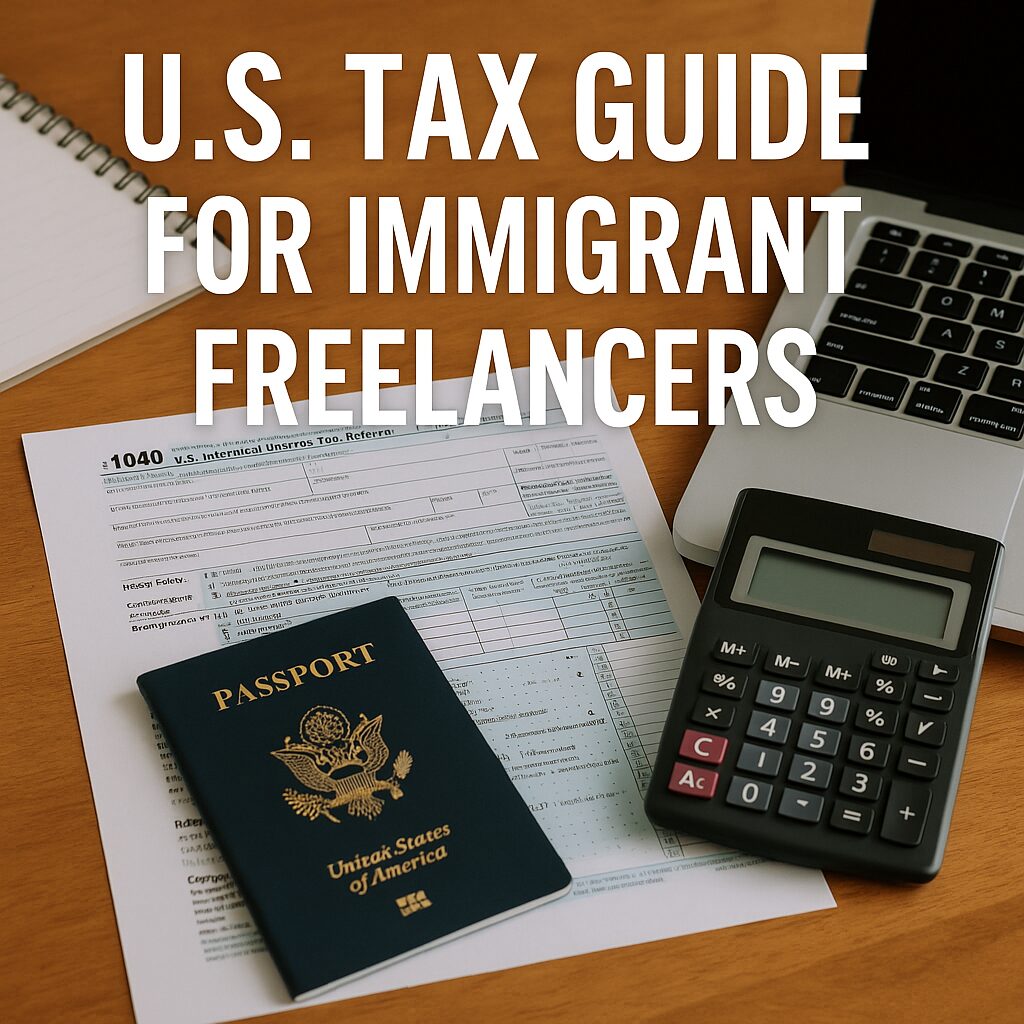Making money as an immigrant freelancer or side hustler in the U.S. is a big achievement. But there’s another challenge that follows: filing your taxes legally and correctly.
If you’re not a U.S. citizen, the tax system can feel confusing — and risky. What forms do you need? What if you don’t have a Social Security Number (SSN)? Will taxes affect your visa or green card?
This guide breaks it all down in simple terms. Whether you’re earning from freelance gigs, YouTube ads, Etsy, or remote work platforms like Upwork, this is your complete roadmap to filing taxes as an immigrant freelancer in the U.S.
1. Do I Have to File Taxes as a Noncitizen Freelancer?
In most cases, yes. If you earn income while living in the U.S. — even from overseas clients — you must report it to the IRS.
You must file taxes if:
- You earned $400 or more in self-employment income
- You’re on a visa (F1, H1B, O1, etc.) and worked legally
- You earned income from platforms like YouTube, Upwork, Etsy, or Patreon
- You are a U.S. resident for tax purposes (more on that below)
Even undocumented immigrants can (and often should) file taxes with an ITIN (Individual Taxpayer Identification Number).
2. Key Definitions: Resident vs. Nonresident for Tax Purposes
The IRS treats you as either a resident alien or nonresident alien — not necessarily the same as immigration status.
| Status | Criteria |
|---|---|
| Resident Alien | Passed the Substantial Presence Test (e.g., lived in the U.S. ≥ 183 days over 3 years) or has a green card |
| Nonresident Alien | Doesn’t meet the test above or just arrived in the U.S. |
Your classification affects what income is taxable and which forms you use.
3. What ID Number Do I Need to File?
- SSN: If you’re eligible (usually via work authorization), use your Social Security Number
- ITIN: If you don’t have an SSN, apply for an ITIN (IRS Form W-7)
- Needed for filing taxes and opening payment accounts
- Takes 7–12 weeks to process
- Available even to undocumented workers
TIP: You can apply for an ITIN when filing your first tax return.
4. What Tax Forms Do Freelancers Need?
Federal Tax Forms (IRS):
| Form | Who Uses It |
|---|---|
| 1040 | Resident aliens (U.S. tax residents) |
| 1040-NR | Nonresident aliens |
| Schedule C | Self-employed income report |
| Schedule SE | Self-employment tax (Social Security + Medicare) |
| Form 1099-NEC | Shows income paid to you by clients (you receive it) |
| Form W-7 | ITIN application form (if no SSN) |
You may also need to file state income taxes if your state requires it.
5. What Counts as Freelance or Side Hustle Income?
Common sources of reportable income:
- Freelance jobs on Upwork, Fiverr, Freelancer
- Etsy, Shopify, eBay sales (even hobbies)
- YouTube AdSense, affiliate links, sponsorships
- Tips or donations from PayPal, Ko-fi, Patreon
- Remote job contracts from global companies
Yes, even crypto income counts if it’s from a business activity.
6. Common Deductions You Might Qualify For
You can reduce your tax bill by claiming business-related expenses. Some common ones:
- Laptop, phone, internet
- Software (Canva, Adobe, Zoom)
- Office supplies
- Home office (pro-rated rent, utilities)
- Marketing, domain fees, hosting
- Education or courses related to your freelance work
- Travel (for work only)
TIP: Keep receipts and track everything — even small expenses add up.
7. How to File Taxes Step-by-Step (for Immigrants)
Step 1: Determine your residency status (IRS vs. immigration)
Use the Substantial Presence Test or green card rule.
Step 2: Gather your documents
- 1099 forms
- Proof of payment (bank, PayPal, Stripe, etc.)
- Expense receipts
- ITIN or SSN
Step 3: Choose how to file
- Self-file using TurboTax, TaxAct, or FreeTaxUSA
- Use a tax preparer experienced with noncitizens
- Nonresident services like Sprintax or Glacier Tax
Step 4: File by the deadline
- Usually April 15
- Use Form 4868 if you need an extension (but still pay taxes on time)
8. Can Filing Taxes Hurt My Visa or Green Card?
Actually, filing taxes properly helps your immigration case. USCIS may ask for tax transcripts during:
- Green card applications (adjustment of status)
- Naturalization
- Change or extension of status
Not filing (or filing incorrectly) can be seen as a red flag.
TIP: Avoid filing as “head of household” unless you truly qualify — USCIS checks for fraud.
9. What If I Earned Income Without Authorization?
Many immigrants have side gigs before they get legal work authorization. Here’s what to know:
- You can still report and pay taxes on unauthorized income
- Use an ITIN to file
- Filing taxes doesn’t legalize past work — but not filing is worse
- You may need to consult an immigration attorney
10. IRS Red Flags to Avoid as a Freelancer
- Underreporting income (they match 1099s to your return)
- Not paying quarterly taxes (if earning $1,000+/year)
- Classifying a hobby as a business to claim deductions
- Excessive deductions with no clear business activity
- Using wrong filing status
TIP: If in doubt, report it. The IRS penalizes underreporting more than overreporting.
Bonus: State & Local Tax Tips
- Some states (like Texas, Florida) have no income tax
- Others (like California, New York) have complex rules
- Some cities even have freelance business licenses or taxes
- If you move, report address changes to the IRS
Check your state’s department of revenue for details.
Tools That Help Immigrant Freelancers
| Tool | Purpose |
|---|---|
| Payoneer / Wise | Global payment collection |
| Keeper Tax | Auto-categorizes freelance expenses |
| QuickBooks Self-Employed | Income & tax tracking |
| Sprintax | Tax prep for nonresident aliens |
| IRS.gov | Free forms & ITIN help |
Conclusion: Pay Less by Filing Smart
Don’t fear taxes — understand them.
As an immigrant freelancer or side hustler, filing taxes right protects your visa and your money.
Start by tracking income. Keep receipts. Use the right forms. Ask for help if needed.
You don’t need to be perfect — just honest, organized, and on time.


